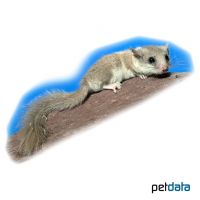African Dormouse (Graphiurus sp.)
| African Dormouse Graphiurus sp. | |
|---|---|
| Name | African Dormouse |
| Name Lat. | Graphiurus sp. |
| Family | Dormice & Hazel Mice |
| Family lat. | Gliridae |
| Order | Rodents |
| Order lat. | Rodentia |
| Origin | Africa |
| Climate | Subtropical - tropical |
| Habitat | Forest, tree steppe |
| Diet | Insects, fruits, green fodder |
| Behavior | Nocturnal; territorial |
| Keeping | Pair, group |
| Care Level | Easy |
| Life Span | 4-6 years |
| Protection | No |
| Metric Units | |
| Size | 8-10 cm |
| Temperature | 20-24 °C |
| Housing | A: 0.5 m² / H: 1 m |
| US Units | |
| Size | 3.1"-3.9" |
| Temperature | 68-75 °F |
| Housing | 5 ft² / 40" hight |
Distribution and habitat
The nocturnal, tree-dwelling pygmy dormice are widespread in sub-Saharan Africa. They inhabit tree hollows or self-made nests in tree-covered areas, from primeval forest to dry sparse bush and tree steppe up to 1,900 m altitude.
Maintenance
Minimum dimensions for the enclosure:
| 2-10 animals | area: 0,5 m² | height: 1 m |
A terrarium placed in a bright (no direct sunlight), draught-free and quiet place is recommended, with ventilation openings at the sides, and it must not be tightly closed at the top.
The enclosure must be structured with plenty of climbing opportunities (rocks, roots, branches, etc.) and provide hiding and shelter opportunities (small bird nest boxes, grass nests, ball nests, cork tubes, etc.). They need feeding and drinking containers as well as nest building material (hay, moss, cotton pods). Commercially available small animal litter, hemp or cotton litter covered with some bark mulch, dry leaves and moss is suitable as a substrate. It is recommended to line the back and side walls with cork boards. Planting is also possible, which, in addition to optical aspects, offers further hiding places. For the wear of their teeth must always be available nail material, such as untreated twigs and branches of fruit trees, and a rodent stone.
| temperature day: 20-24 °C | temperature night: 18-20 °C |
A natural day-night rhythm must be ensured
Diet
They feed on a variety of foods depending on the season. The species-specific diet consists of a mixture of dwarf hamster and gerbil food available in specialized stores, supplemented with sweet fruit (grapes, pears, apples, peaches, etc.), some fresh food (wild herbs, root vegetables) and a mineral stone. In addition, they need animal protein, such as live insects (crickets, house crickets, mealybug larvae), a hard-boiled hen's egg, cottage cheese, natural yogurt, insect food for hedgehogs or cat food. Better than a nipple drinker is a shallow clay bowl. Although they drink little, drinking water must always be available and, like food, should be offered fresh daily
A varied diet promotes health and prevents deficiency symptoms.
Behaviour and compatibility
They are sociable animals and should only be kept in family groups. Towards foreign animals they behave territorial. Socialization should only take place during the day. At the first signs of incompatibility, the animals should be separated immediately.
Reproduction and breeding
In juvenile males, the distance between the anus and the urethral opening is greater than in females.
The gestation period is about 21 days. A litter consists on average of 2-4 young, which are born naked, blind and deaf. After 12-16 days the eyes open. The young are suckled for about 40 days. They are sexually mature after about 4 months. A female has up to 3 litters per year.
Important
There are 14 difficult to distinguish species, which all have similar requirements for keeping and care. In the trade mostly G. murinus or G. kelleni are offered
A basking place irradiated with a heat lamp (spot) is gladly visited also during the day. By installing moonlight lamps they can also be observed at night.
They jump far (tail as a balancing organ) and climb very well with the help of their pointed claws and sticky secretions from glands on the sole pads. Their sense of smell, hearing and touch is highly sensitive. In case of lack of food or temperatures below 15 °C they fall into a rigidity (torpor) in which they appear as if dead. If disturbed, it can take up to 30 minutes for them to awaken
As escape animals they need sufficient retreat and hiding places. They must not be grabbed or pulled by the tail. Lighting and heat lamps should be positioned to prevent injury to the animals. Care must be taken to ensure thorough hygiene and contamination must be removed regularly.
Further literature can be found in your pet store.
References
Text: petdata; Image: petdata
Source: W. PUSCHMANN, D. ZSCHEILE, K. ZSCHEILE (2009): Zootierhaltung - Tiere in menschlicher Obhut: Säugetiere, Harri Deutsch Verlag; BMEL (2014): Gutachten über Mindestanforderungen an die Haltung von Säugetieren
- Gemäß § 21 Abs. 5 Tierschutzgesetz idgF
